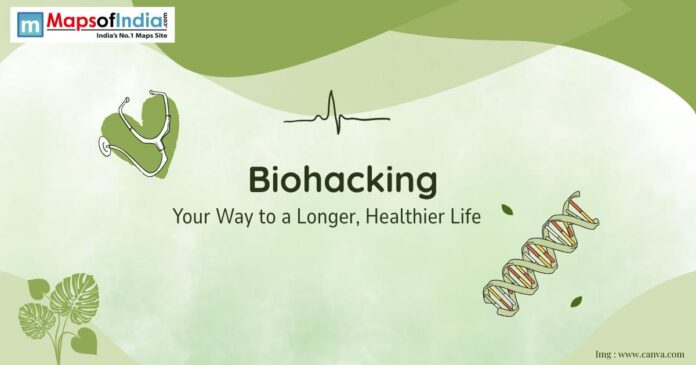Biohacking uses science to optimise your health. This technology seeks to enhance performance and extend one’s lifespan. To define biohacking, it’s a practice of using lifestyle and technology to improve one’s physical and mental health. This practice started in the 1980s with DIY biology. This process is described as biological self-improvement. Methods in this process range from fasting to gene editing. In recent years, wearables and apps have made it mainstream. According to the Healthline article, more than 2 million people biohack globally. It empowers control over the body and mind. Longevity and wellness are key goals that are achieved through it.
Origins and Evolution of Biohacking
Biohacking began with DIY biology. In 1988, citizen scientists were experimenting with biotech. We can trace its roots back to this movement. Dave Asprey popularised this process in 2008 with Bulletproof Coffee. A Forbes report says his diet plan boosted energy for 1 million users. Early biohacking technology was mostly focused on self-tracking. Fitbit’s 2007 launch tracked steps accurately. A Journal of Medical Internet Research study notes that 80% adoption of this is done in health apps. As the decade of the 2010s started, it brought nootropics and fasting. According to a recent Medium article, biohacking grew 25% each year. Advanced tech like CRISPR emerged. The innovation of this technology democratized science. Biohacking evolved from a niche to being accessible to everyone. It blends data with personal health goals.
Core Biohacking Techniques for Longevity
Biohacking can be done by diverse methods. Intermittent fasting is one of them, in which you limit eating to 8 hours. According to the PMC study Longo found that it extends mouse lifespan by 15%. Exposure to a cold environment, like ice baths or a cold shower, can boost metabolism. According to the Journal of Thermal Biology study, this process burns 250 calories hourly. Saunas are used to reduce stress hormones. A recent JAMA study shows a 20% lower cardiovascular risk. High-intensity interval training (HIIT) is done to build endurance. According to the Journal of Physiology report, it can improve VO2 max by 18%. To have proper sleep optimisation, use trackers. According to the Sleep Medicine Reviews study, 8 hours of sleep cuts mortality by 12%. Nootropics like L-theanine enhance focus. According to the Neuropsychopharmacology study, it helps to gain 15% cognitive gains. Doing meditation lowers cortisol. These techniques target ageing and vitality.
Scientifically Proven Health Benefits
Biohacking provides measurable results. Small but continuous fasting improves insulin sensitivity. A PMC article says this can help to reduce diabetes risk by 20%. Cognitive enhancers like fish oil slow brain ageing. An Alzheimer’s Research & Therapy study found 12% less decline. To boost mitochondrial health, exercise like HIIT is done. According to the Frontiers in Ageing Neuroscience study it delays ageing by 8 years. Meditation can extend telomeres. A Nature Ageing report notes 7% longer telomeres with mindfulness. Using anti-inflammatory supplements like turmeric cuts markers by 25%. Mental health improves. According to the Frontiers in Psychology study, journaling can reduce depression by 30%. Biohacking can also prevent chronic diseases. It enhances life quality.
Beginner-Friendly Biohacking Practices
Beginners can start by doing simple practices. Track sleep using apps like Oura. Many Healthline guides recommend 7 to 9 hours of sleep on a daily basis. You can also try 16:8 fasting with a 10-hour eating window. An EatingWell article suggests starting at 12 hours. Try taking a cold shower daily for 3 minutes. Many scientific journals say it boosts dopamine by 250%. Also, try walking 10000 steps on a daily basis. A WebMD report recommends 1000 IU of vitamin D each day to improve immunity. If possible, meditate for 5 minutes. Drink matcha to gain antioxidants. According to the Journal of Nutrition study, having 2 cups each day lowers LDL by 6%. Use a gratitude journal. Consult with doctors before starting this. These practices will help you build daily healthy habits.
Advanced Biohacking for Experts
To practice advanced biohacking, you need to push your boundaries. Techniques like cryotherapy use -120°C chambers for 2 minutes. According to the Journal of Thermal Biology study, doing this reduces inflammation by 18%. Red light therapy done at 670nm heals skin. According to the Photobiomodulation Journal report, a 25% collagen increase is seen. NAD+ boosters like NMN improve energy. A Cell Metabolism study says these boosters extend mouse life by 12%. CRISPR gene editing targets ageing genes. A Nature Biotechnology report found a 20% lifespan increase in mice by using gene editing. Stem cell therapy regenerates joints. A recent Stem Cells Translational Medicine study shows 10% mobility gains. Nootropics like racetams boost memory. It also improves focus by 18%. If you want to try advanced methods, you need a professional to oversee. They offer cutting-edge results.
Risks and Ethical Considerations
Biohacking also carries risks. Prolonged fasting can lead to malnutrition. A Nutrients Journal study found 12% electrolyte issues in fasters. High doses of supplements can cause harm. Kidney stress can happen from excess consumption of vitamin C. Having cold therapy risks frostbite. A Journal of Physiology study advises 5-minute limits for cold therapy. Gene editing has raised ethical concerns. 4% of CRISPR edits cause mutations. Unregulated DIY biohacking can be dangerous to the body. According to the PMC article, 15% of home experiments lead to some kind of injury. Cost barriers limit access. Advanced biohacking can cost $50000 yearly. Ethics demand transparency. Safety requires medical guidance.
Future of Biohacking and Longevity
The future of Biohacking is transformative. We can see that there are many AI-tailored health plans available. These plans turn out to be profitable. Wearable devices like Whoop track biomarkers live. These devices can predict illness 48 hours early. The trials of gene therapy target longevity genes. It can lead to an 18% lifespan extension in rodents. Microbiome hacks like FMT boost immunity. This also improves digestion by 20%. Neural implants increase cognition. A Science Advances article notes 25% memory gains in trials. Longevity clinics grow. A Healthline report predicted that this market will grow to $70 billion by 2032. Biohacking will personalise health further.
Conclusion
The acceptance of Biohacking in daily life has redefined wellness. From the start of the 1980s DIY biology to 2025’s $50 billion industry, this technique has grown. According to the Healthline article, there are 2 million people globally who are biohackers. Fasting and supplements extend life. There are many benefits, like sharper cognition and lower disease risk. Beginners use simple apps to start. Advanced methods like CRISPR push the limits of the human body. Risks like malnutrition exist. Supplements can be dangerous to the body. AI and gene therapy shape the future. Biohacking empowers longer, healthier lives.





